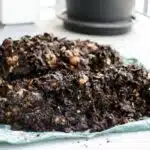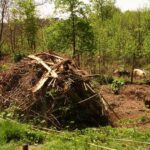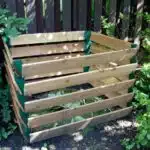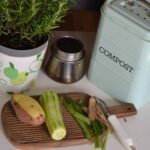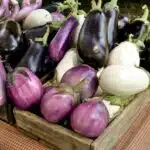Composting is an excellent way to reduce waste, enrich soil, and produce organic matter for your garden. However, traditional composting methods can take a long time to produce usable compost. Hot composting is a technique that speeds up the decomposition process, resulting in finished compost in as little as four weeks.
Hot composting involves creating an optimal environment for microorganisms that break down organic matter. By managing moisture, temperature, and air flow, hot composting accelerates the natural process of decomposition. In this article, we will explore the benefits of hot composting and provide step-by-step instructions on how to make your own hot compost pile. Whether you are a seasoned gardener or new to composting, this guide will help you create nutrient-rich soil amendments quickly and efficiently.
The Benefits Of Composting
Composting is like a natural recycling process that transforms food scraps, yard trimmings, and other organic matter into nutrient-rich soil. The benefits of composting are numerous, ranging from environmental sustainability to personal health. Composting is an eco-friendly way to manage waste, reduce greenhouse gas emissions, and promote healthy soil.
Sustainability is one of the primary benefits of composting. Instead of sending organic waste to landfills where it takes up space and emits methane – a potent greenhouse gas – composting turns waste into a valuable resource. Composting creates nutrient-rich soil that can be used to grow healthy plants without relying on chemical fertilizers. This not only reduces reliance on synthetic chemicals but also promotes biodiversity by enhancing soil quality.
Furthermore, composting has positive implications for personal health as well. When we choose to compost our food scraps and yard trimmings instead of throwing them away in plastic bags, we help reduce the amount of plastic that ends up in landfills or oceans, which can have harmful effects on human health and the environment. By choosing to compost, we contribute towards creating a healthier planet for ourselves and future generations to come.
Understanding the science behind composting is essential in maximizing its benefits. Knowing how different organic materials break down and what conditions facilitate decomposition allows us to create optimal conditions for our composting system.
Understanding The Science Behind Composting
Composting is a natural process of breaking down organic materials into a nutrient-rich soil-like material known as compost. The process involves the use of microbes that break down organic matter into simpler forms, which are then used by plants for growth and development. Composting techniques vary depending on the type of material being composted, the desired end product, and available resources.
Microbial activity is an essential component of the composting process. Microbes such as bacteria, fungi, and other decomposers break down complex organic compounds into simpler forms through a process called mineralization. In this process, microbes consume carbon-based materials such as leaves, twigs, and food scraps to produce carbon dioxide and water while releasing nutrients such as nitrogen and phosphorous.
Understanding the science behind composting can help you optimize your composting efforts and achieve faster results. By providing ideal conditions for microbial activity to thrive during hot composting, you can speed up the decomposition process significantly. This includes maintaining proper moisture levels, temperature ranges between 130-160°F (55-70°C), sufficient oxygen supply, and adequate mixing to ensure uniformity. In the next section, we will explore how microorganisms break down organic material in more detail to help you understand how to create optimal conditions for hot composting.
How Microorganisms Break Down Organic Material
Microbial activity is a critical component of the composting process. These tiny organisms break down organic materials, transforming them into nutrient-rich soil amendments. Without microbes, the composting process would be slow or even non-existent. The most important microorganisms involved in composting are bacteria, fungi, and actinomycetes.
Bacteria are responsible for breaking down simple sugars and starches. They are the first to start working on your compost pile, consuming easily digestible materials and reproducing rapidly. Fungi come next, breaking down materials that bacteria cannot digest (such as cellulose). Actinomycetes are slower-acting than bacteria or fungi but play an essential role in breaking down tough plant matter like wood chips and stems.
Understanding the microbial activity involved in composting is crucial to producing high-quality compost quickly. By providing the right conditions for these microorganisms to thrive (such as adequate moisture levels and proper aeration), you can speed up the composting process significantly.
• Five items to draw in and keep readers interested:
- How to troubleshoot common issues with microbial activity
- The difference between aerobic and anaerobic decomposition
- How temperature affects microbial activity
- The benefits of using compost tea
- How different types of organic matter affect microbial populations – and ultimately, the quality of your compost
The Basics Of Hot Composting
The process of hot composting can be a game-changer for those who have struggled with traditional composting methods. With hot composting, you can create rich and fertile soil in less time, making it the perfect solution for those who are looking to grow their own food or simply reduce waste. Hot composting requires a bit more effort upfront, but the rewards are well worth it.
One important aspect of hot composting is selecting the right composting containers. While there are many different options available on the market, not all containers are created equal. It’s important to choose a container that is large enough to hold all of your organic materials and has good ventilation to allow for proper airflow. You’ll also want to consider the material of your container – plastic bins tend to retain heat better than metal ones.
Troubleshooting odor is another common issue that arises during hot composting. If your pile has a foul smell, it’s likely due to too much moisture or not enough air circulation. To remedy this, try turning your pile more frequently or adding more dry materials like leaves or straw. It’s also important to avoid adding any meat or dairy products as these can attract unwanted pests and emit unpleasant odors. By following these simple tips, you’ll be well on your way to creating nutrient-rich soil through hot composting.
When it comes down to selecting the right materials for your compost pile, there are a few things you need to keep in mind. First and foremost, you want to make sure that you’re using organic materials that will break down easily over time. This includes items like fruit and vegetable scraps, coffee grounds, eggshells, and yard waste like grass clippings and leaves. Avoid using any items that may contain pesticides or chemicals as these can harm your plants in the long run. With the right combination of organic materials and proper care techniques, your hot compost pile will be thriving in no time.
Selecting The Right Materials For Your Compost Pile
Composting materials play a crucial role in the success of your hot compost pile. Organic waste selection is essential because it affects the quality and nutrient value of the end product. The right combination of materials will provide optimal carbon-to-nitrogen ratios, which are necessary for microbial activity and decomposition.
To select the best organic waste for your compost pile, consider these three factors:
Diversity: A diverse range of materials ensures that the compost contains a variety of nutrients and microorganisms. Mix kitchen scraps with yard waste, such as leaves or grass clippings, to create an ideal balance.
Size: Cut or shred larger materials into smaller pieces to speed up decomposition. Smaller particles have more surface area for microorganisms to work on.
Moisture: Keep your compost pile moist but not waterlogged. Aim for a consistency similar to a wrung-out sponge. This will allow microorganisms to thrive without drowning.
By following these guidelines, you can create an ideal environment for decomposers to break down organic matter and produce high-quality compost. Remember that composting is a natural process, so don’t be afraid to experiment with different materials and ratios until you find what works best for your situation.
Now that you know how to select the right materials for your hot compost pile let’s move onto building it!
Building Your Hot Compost Pile
First and foremost, before building your hot compost pile, ensure that you have a compost bin that is at least 3 feet by 3 feet in size. The bin should be constructed using a material that allows for proper airflow and heat retention such as chicken wire or pallets. Building the pile directly on the ground will allow earthworms to naturally aerate the compost.
Once you have your compost bin, it’s time to start building your hot compost pile. Begin by layering brown materials such as dried leaves or wood chips followed by green materials such as food scraps and grass clippings. Continue layering until the pile reaches 3 feet in height. It’s crucial to maintain a proper carbon-to-nitrogen ratio of roughly 25-30:1 for optimal decomposition.
To ensure rapid decomposition, turning frequency is key. Turn the pile every three days during the first week, then every five days during the second week, and every seven days thereafter until it’s fully decomposed. Turning helps to distribute oxygen throughout the pile and promote even decomposition. A well-managed hot compost can reach temperatures of over 140°F which will kill harmful pathogens and weed seeds while breaking down organic matter into nutrient-rich soil amendment.
Managing moisture for optimal results is essential when hot composting. In the subsequent section, we’ll explore how to maintain proper moisture levels throughout the process to ensure your hot compost reaches its full potential.
Managing Moisture For Optimal Results
Moisture management is crucial for hot composting success. Too much or too little water can hinder the decomposition process, resulting in a smelly and ineffective pile. The ideal moisture level for a compost pile is around 50-60%, which can be achieved by regularly monitoring and adjusting the hydration of your compost.
Compost pile hydration can be managed through various methods, such as adding water directly to the pile or covering it with a tarp to prevent moisture loss. Another effective technique is incorporating materials with different levels of moisture, such as dry leaves or wet food scraps, to balance out the overall moisture content of the compost. Additionally, turning the pile frequently helps distribute water evenly throughout.
Proper moisture management not only accelerates decomposition but also promotes a healthy microbial environment in your compost pile. A well-hydrated pile supports the growth of beneficial bacteria and fungi that break down organic matter into nutrient-rich soil amendments. By mastering moisture control techniques, you’ll be on your way to producing high-quality compost in less time.
As you perfect your moisture management skills, it’s important to also consider temperature control for faster decomposition. Maintaining optimal temperatures within your compost pile will further speed up its transformation into usable soil amendments. In the next section, we’ll explore various techniques for regulating temperature and maximizing hot composting efficiency.
Temperature Control For Faster Decomposition
Hot composting requires a carefully controlled environment, and temperature monitoring is an essential aspect of the process. The ideal temperature range for hot composting is between 120°F and 160°F, with a peak temperature of around 140°F. To achieve these temperatures, the compost pile must be actively managed to ensure that it reaches and maintains the right conditions. Temperature can be monitored using a probe thermometer, which should be inserted into the center of the pile.
One way to maintain high temperatures in your compost pile is by using insulating materials. These materials help to retain heat within the pile and prevent it from escaping into the surrounding environment. Commonly used insulating materials include straw, hay, leaves, or wood chips. These materials can be added in layers between organic matter to help trap heat inside the pile. Additionally, covering your compost with a tarp or plastic sheet can also help to keep heat inside.
Proper temperature control is crucial for hot composting success. Monitoring temperatures daily during active decomposition ensures that the process remains on track and that optimal conditions are maintained throughout the pile. By using insulating materials such as straw or hay and monitoring temperatures regularly with a probe thermometer, you’ll be able to create an ideal environment for fast decomposition.
Maintaining proper temperature levels is just one aspect of creating successful hot composts; another critical factor is ensuring adequate air flow throughout the pile. Inadequate airflow can lead to anaerobic conditions, which slows down decomposition rates and produces unpleasant odors. In order to maintain proper airflow within your compost pile, it’s important to turn it regularly and incorporate bulking agents such as shredded paper or dry leaves into your layers of organic matter.
The Importance Of Air Flow
Air flow is a crucial factor in hot composting. The pile needs oxygen to support the microorganisms that break down the organic matter into compost. Without proper aeration, the pile can become anaerobic, leading to unpleasant odors and slow decomposition. Therefore, it is essential to ensure adequate air flow throughout the pile.
Tips for proper aeration include turning the pile regularly and adding bulky materials such as straw or wood chips. Turning the pile allows oxygen to penetrate deep into the center of the heap, where decomposition occurs most actively. Additionally, adding bulky materials creates spaces between the particles of organic matter, allowing air to circulate.
Another important consideration is maintaining an appropriate moisture level within the pile. A moist but not saturated environment promotes microbial growth and activity while preventing excessive drying out that can impede oxygen movement. Checking moisture levels periodically and watering as necessary will help maintain optimal conditions for air flow and decomposition.
Proper aeration is vital for achieving fast and efficient hot composting results. By ensuring adequate air flow throughout your compost pile through regular turning, adding bulky materials, and maintaining appropriate moisture levels, you can create an ideal environment for microbial action and produce high-quality compost in less time.
Transition: Now that we understand how important air flow is for successful hot composting let’s move on to another critical step: turning your compost pile.
Turning Your Compost Pile
Once you have built your hot compost pile, it is important to turn it regularly. Turning the pile helps mix the materials, introduce oxygen, and regulate the temperature. This process can speed up decomposition and help you achieve finished compost in less time.
Benefits of turning your compost pile include creating a more homogeneous mixture, increasing airflow, and allowing for more efficient microbial activity. However, there are also some challenges that come with turning your pile. For example, if you turn the pile too frequently or too aggressively, you may disrupt the balance of moisture and air. This can slow down decomposition or even cause anaerobic conditions that produce unpleasant odors.
To turn your hot compost pile effectively, use a pitchfork or shovel to lift and mix the materials from the bottom to the top of the heap. Be careful not to damage any roots or other organic matter in your mixture. Also, avoid turning too frequently – once every few days should be sufficient for most piles. Remember to monitor moisture levels and add water as needed to maintain an optimal level of around 50-60% humidity.
Next on our hot composting journey is troubleshooting common issues that may arise during the process. By understanding these challenges and how to overcome them, you can ensure that your hot composting experience is successful from start to finish.
Troubleshooting Common Hot Composting Issues
As you begin your hot composting journey, it’s important to know that issues may arise during the process. However, don’t let this discourage you from making high-quality compost in less time. With a few troubleshooting tips and solutions for common problems, you can successfully tackle any challenge that comes your way.
One common issue is an unpleasant odor emanating from your compost pile. This could be due to an imbalance of carbon and nitrogen materials or insufficient oxygen levels. To solve this problem, ensure that you have a 2:1 ratio of carbon to nitrogen materials and turn your pile regularly to introduce oxygen. Another issue is a lack of heat in your compost pile, which could be due to too little moisture or inadequate material quantity. To rectify this, add more green (nitrogen-rich) materials or sprinkle water on your pile if it’s too dry.
Another common issue is the presence of pests such as rodents or insects in your compost pile. This could be due to adding food scraps with animal products or not burying them deep enough into the pile. Solutions include burying food scraps deeper into the pile and avoiding adding animal products like meat and dairy.
With these troubleshooting tips and solutions for common issues in mind, you’re now equipped to handle any obstacle that may come up during hot composting. In the next section, we’ll discuss how to harvest your finished compost without disrupting ongoing compost production.
Harvesting Your Finished Compost
- The process of sifting finished compost helps to separate out the larger pieces of material that may not have composted fully, allowing for a more consistent end product.
- Finishing compost can be done by sifting out material by hand or by using a sifter or tumbler.
- Unused compost should be disposed of carefully, as it may contain weed seeds or pathogens that could spread to other areas of the garden.
- Compost can be disposed of in a number of ways such as composting it further, using it as mulch, giving it away, or simply disposing of it in a landfill.
Sifting The Compost
Compost sifting is a crucial step in harvesting your finished compost. This process involves separating the larger pieces of organic material from the fine, crumbly compost. Sifting is important because it helps improve the texture of your compost and makes it easier to use in your garden.
To sift your compost, you’ll need a large screen or mesh that will allow the small particles of compost to fall through while holding back the larger pieces. You can either purchase a compost sifter or make one yourself using materials such as wire mesh or hardware cloth. Once you have your sifter ready, simply shovel some of your finished compost onto it and shake it gently until all of the fine particles have fallen through. The larger pieces can then be added back into your compost pile to continue breaking down.
Improving texture is crucial in creating high-quality compost that will benefit your plants and soil. Sifting removes any large clumps or debris that may not have fully decomposed, producing a uniform and consistent texture throughout your finished product. By taking the time to sift your compost, you’ll be rewarded with nutrient-rich soil that will help promote healthy plant growth and improve overall soil health.
Disposing Of Unused Compost
As a hot composting expert, one of the most critical steps in the composting process is harvesting your finished compost properly. Once you’ve sifted out all of the large pieces and debris from your compost, it’s time to figure out what to do with any unused material. Fortunately, there are several options available for disposing of your excess compost.
One way to put unused compost to good use is by starting a worm bin or vermicomposting system. Worms are fantastic at breaking down organic matter and can turn your leftover compost into nutrient-rich worm castings that are ideal for indoor plants or small gardens. Vermicomposting is an excellent alternative for those who don’t have space for an outdoor compost pile.
Another option for disposing of unused compost is to give it away to friends and family members who garden or donate it to community gardens or local farmers markets. Compost is highly valued by gardeners and farmers as it is an excellent source of nutrients for soil improvement and plant growth. By sharing your excess compost with others, you’ll be helping them grow healthy crops while reducing waste.
In conclusion, harvesting your finished compost properly means sifting out any large pieces and deciding what to do with any unused material. Fortunately, there are several options available, including starting a worm bin or vermicomposting system and sharing your excess compost with others through donations or giveaways. By finding creative ways to dispose of unused material, you’ll be making a positive impact on the environment while also serving others in your community.
Using Compost In Your Garden
Compost is a nutrient-rich soil amendment that can benefit your garden in numerous ways. When used as a top dressing or incorporated into the soil, it can improve soil structure and fertility, promote healthy root growth, and suppress plant diseases. Another way to use compost in your garden is by making compost tea. Compost tea is a liquid fertilizer made from steeping compost in water. It can be applied as a foliar spray or directly to the soil to provide plants with an extra boost of nutrients.
If you’re interested in taking your composting efforts to the next level, consider vermicomposting. Vermicomposting is the process of using worms to break down organic materials into nutrient-rich vermicastings, also known as worm castings. Worm castings are an excellent source of plant nutrients and can be used as a top dressing or mixed into potting soil for container gardening. In addition, vermicomposting has several advantages over traditional hot composting methods, such as faster decomposition rates and reduced greenhouse gas emissions.
In summary, using compost in your garden has many benefits for both plants and the environment. By incorporating compost into your soil or making compost tea, you can improve soil fertility and promote healthy plant growth. If you’re looking for an advanced form of composting, consider vermicomposting basics to produce high-quality worm castings for your garden. Next, we will explore the differences between hot composting vs. traditional composting methods when it comes to creating nutrient-rich soil amendments for your garden beds.
Hot Composting Vs. Traditional Composting Methods
Hot composting is an accelerated method of composting that can create compost in a much shorter time frame than traditional composting. In order to make compost quickly, hot composting requires materials that are high in nitrogen, such as vegetable and fruit scraps, green lawn clippings, and manure. Additionally, hot composting requires temperatures of around 140 degrees Fahrenheit to be maintained in order for the process to be successful. Traditional composting uses a variety of materials, including fruit and vegetable scraps, grass clippings, leaves, and manure, and does not require the same high temperatures as hot composting. While it does take longer to make compost using traditional methods, the process is more forgiving and does not require as much maintenance.
Time Involved
Hot composting is a technique that allows you to make compost in less time than traditional methods. One of the significant benefits of hot composting is that it allows for a higher frequency of composting. Traditional methods often require several months before you can harvest your compost, which limits your ability to continuously produce new soil for your garden. Hot composting, on the other hand, allows for a quicker turnover rate and more frequent batches.
To achieve this higher frequency, hot composting requires specific techniques. The key to creating a hot compost pile is to have the right balance of carbon-rich materials, such as leaves and straw, and nitrogen-rich materials, such as kitchen scraps and grass clippings. These materials need to be layered correctly in a specific order to create an environment that encourages microbial activity and heat generation. By following these techniques, you can create a hot compost pile that will reach temperatures between 120-160 degrees Fahrenheit.
Overall, the time involved in hot composting is significantly less than traditional methods. With proper techniques and attention to detail, you can expect your hot compost pile to be ready in as little as four weeks. This means you can produce more soil throughout the year and enjoy healthier plants in your garden without waiting months for your next batch of compost. In conclusion, by understanding the principles behind hot composting and implementing proper techniques, you can reduce your wait time significantly while producing quality soil for all your gardening needs.
Materials Used
When it comes to hot composting, the materials you use are essential to creating an environment that encourages microbial activity and heat generation. Carbon-rich materials, such as leaves and straw, are necessary for providing the energy source that microbes need to break down organic matter. Nitrogen-rich materials like kitchen scraps and grass clippings provide protein, which helps the microbes grow and reproduce. However, not all composting materials are created equal.
To achieve optimal results in hot composting, there are certain materials you should avoid using. These include meat, dairy products, and oily foods that can attract pests or produce unpleasant odors. It’s also best to steer clear of diseased or insect-infested plant material that can spread harmful pathogens throughout your compost pile. When sourcing your compost materials sustainably, try to find local sources for leaves, straw, and other carbon-rich materials rather than purchasing them from commercial sources that may contribute to environmental degradation.
In addition to choosing the right materials for your hot compost pile, there are a few tips you can follow to ensure success. First off, make sure you have enough of each material type by gathering at least three times more carbon-rich than nitrogen-rich materials. Be sure to chop up any large pieces of material into smaller bits so they can decompose faster. Finally, keep your compost pile moist but not too wet – aim for it to feel like a damp sponge when squeezed in your hand. By following these guidelines on composting materials and techniques, you’ll be well on your way towards producing nutrient-rich soil for your garden in no time!
Temperature Requirements
Hot composting is a highly effective technique for turning organic waste into nutrient-rich soil quickly. One of the key factors that differentiates hot composting from traditional composting methods is the temperature at which it operates. Unlike traditional composting, which relies on slow microbial activity to break down organic matter, hot composting relies on thermophilic bacteria growth to generate heat within the pile. This high level of heat accelerates the decomposition process and kills off harmful pathogens and weed seeds.
To achieve optimal results in hot composting, it’s essential to maintain a specific temperature range throughout the process. The ideal temperature range for a hot compost pile is between 135-160°F (57-71°C). At these temperatures, thermophilic bacteria thrive and can break down organic matter in as little as four to six weeks. To ensure that your pile reaches and maintains this temperature range, it’s important to monitor regularly with a thermometer and adjust your materials accordingly.
Hot composting requires careful management of both materials and temperature to achieve success. It’s essential to have enough carbon-rich materials such as leaves, straw, or wood chips to provide energy for microbial activity. Nitrogen-rich materials such as food scraps or grass clippings should be added in moderation to prevent an imbalance that could slow down decomposition or produce unpleasant odors. By following these guidelines on material selection and temperature management, you can create nutrient-rich soil for your garden in no time!
Frequently Asked Questions About Hot Composting
As we have previously discussed, hot composting is a method of making compost that can be completed in less time compared to traditional methods. This makes hot composting an attractive option for those who want to produce high-quality compost quickly. However, to achieve success with hot composting, it is important to follow specific guidelines and avoid common mistakes.
One of the most common mistakes made during hot composting is improper layering. Layering is crucial in hot composting as it helps create the right balance of carbon and nitrogen for the microorganisms responsible for decomposition. Failure to layer properly can result in a slow, smelly, and ineffective process. Another mistake is not maintaining proper moisture levels. Compost needs moisture to break down effectively, but too much or too little water can hinder the process.
Hot composting troubleshooting involves identifying and addressing problems that may arise during the process. One issue that may arise is overheating due to excessive nitrogen-rich material or insufficient oxygen supply. Overheating can kill off beneficial microorganisms and cause foul odors. Another problem may be an unpleasant smell emanating from the pile, which could indicate that there are anaerobic conditions present.
To prevent these common mistakes and ensure successful hot composting, it’s essential to pay attention to details such as proper layering techniques and maintaining adequate moisture levels. Troubleshooting should also involve monitoring temperature levels regularly and addressing any issues promptly before they become major problems. By following these guidelines, one can produce nutrient-rich soil amendment in a shorter amount of time while avoiding common pitfalls associated with hot composting techniques.
Conclusion
Composting is an essential aspect of sustainable living, and hot composting can make it even better. By understanding the science behind composting, you can create a nutrient-rich compost in just a few weeks. Hot composting generates heat that speeds up the decomposition of organic material and kills weed seeds and harmful pathogens.
To start hot composting, select the right materials for your compost pile, including nitrogen-rich greens and carbon-rich browns. Once you have built your pile, monitor its temperature regularly to ensure it stays between 120-160°F for optimal results. When your compost is ready, harvest it by sifting out any large pieces and using it to enrich your garden soil.
Hot composting has numerous benefits over traditional methods. It reduces greenhouse gas emissions by preventing methane production, eliminates odors and pests, and produces a more nutrient-dense fertilizer for your plants. Through hot composting, we can not only reduce our environmental impact but also improve the health of our gardens in a natural way. So let’s get started!
Image Credits
- “building a compost pile for hot water” by fishermansdaughter (featured)


